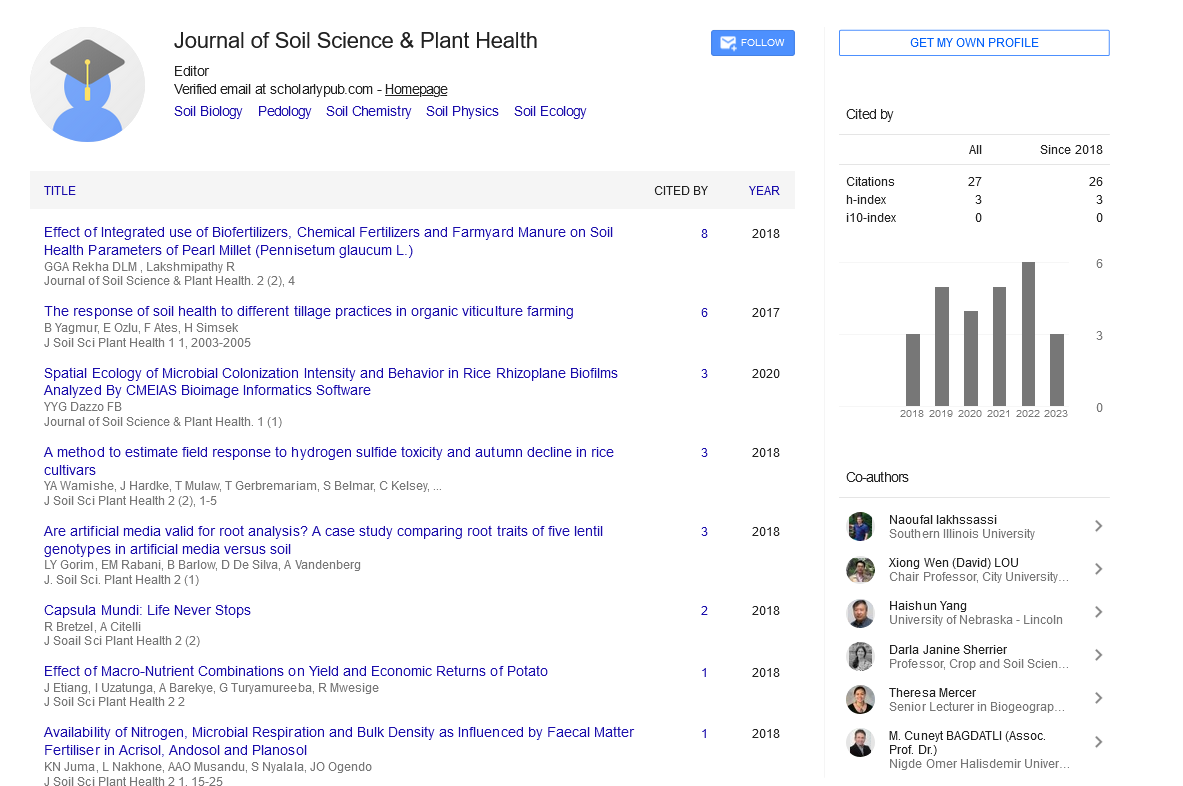Commentary, J Soil Sci Plant Health Vol: 8 Issue: 1
Enhancing Soil Fertility through Sustainable Agricultural Practices
Lee Won*
Department of Agricultural Sciences, China Agricultural University, Haidian, Beijing, China
- *Corresponding Author:
- Lee Won
Department of Agricultural Sciences,
China Agricultural University,
Haidian,
Beijing,
China
E-mail: leewon12@gmail.com
Received date: 27 October, 2023, Manuscript No. JSPH-23-118467;
Editor assigned date: 30 October, 2023, PreQC No. JSPH-23-118467 (PQ);
Reviewed date: 13 November, 2023, QC No. JSPH-23-118467;
Revised date: 05 January, 2024, Manuscript No. JSPH-23-118467 (R);
Published date: 12 January, 2024, DOI: 10.4172/jsph.1000215
Citation: Won L (2024) Enhancing Soil Fertility through Sustainable Agricultural Practices. J Soil Sci Plant Health 8:1.
Description
Soil is a non-renewable resource that plays a fundamental role in agriculture, influencing crop productivity and overall food security. Soil fertility, a critical component of soil quality, determines its ability to provide essential nutrients to plants. However, conventional agricultural practices, characterized by intensive tillage, excessive chemical fertilizer use, and monoculture cropping, have contributed to soil degradation and a decline in fertility. This manuscript explores the impact of conventional practices on soil fertility and highlights the importance of sustainable agricultural approaches in enhancing and preserving soil fertility.
The significance of soil fertility
Soil fertility encompasses various factors that collectively contribute to its ability to support plant growth:
Soil fertility influences the availability of essential nutrients, including nitrogen, phosphorus, and potassium, which are vital for plant growth and development.
Fertile soils maintain a favorable structure, promoting root penetration, water infiltration, and aeration, all of which are crucial for plant health.
Healthy soils host diverse and active microbial communities that contribute to nutrient cycling, organic matter decomposition, and overall soil vitality.
Fertile soils contain substantial amounts of organic matter, which improves water-holding capacity, nutrient retention, and microbial activity.
Conventional agricultural practices have brought about several challenges that compromise soil fertility: Intensive tillage and inadequate ground cover have made soils susceptible to erosion, leading to the loss of topsoil, essential nutrients, and soil structure.
Heavy reliance on chemical fertilizers has disrupted natural nutrient cycling and created imbalances in nutrient availability.
Chemical inputs, especially synthetic pesticides and fertilizers, have adverse effects on soil microorganisms, impairing their functions in nutrient cycling and organic matter decomposition.
Sustainable agricultural practices prioritize the preservation and enhancement of soil fertility through environmentally friendly, ecologically sound, and economically viable approaches:
No-till or reduced tillage practices minimize soil disturbance, maintain soil structure, and reduce erosion, thus enhancing soil fertility.
The use of cover crops during fallow periods adds organic matter to the soil, prevents erosion, and improves nutrient cycling.
Crop rotation diversifies plant species in a field, reducing nutrient depletion and suppressing pests and diseases.
Organic farming practices prioritize soil health through the incorporation of organic matter, compost, and natural fertilizers.
Precision agriculture employs technology to precisely apply fertilizers and manage irrigation, reducing nutrient wastage and environmental impact.
The integration of trees and crops in agroforestry systems enhances soil fertility through organic matter addition and nutrient cycling.
Effective restoration and maintenance of soil fertility often involve the combination of these sustainable practices:
Regular soil testing is essential for understanding soil nutrient status and for making informed decisions about nutrient application.
Retaining crop residues on fields adds organic matter, enhances nutrient cycling, and improves water retention.
Proper nutrient management aims to balance nutrient inputs and outputs, ensuring that nutrients are replenished in alignment with crop requirements.
Combining sustainable pest management strategies with soil health practices promotes a balanced and healthy soil ecosystem.
Implementing erosion control measures, such as terracing and buffer strips, is crucial for maintaining soil structure and fertility.
The adoption of sustainable soil management practices carries numerous benefits for agriculture, the environment, and society at large:
Enhanced soil fertility results in higher crop yields and improved food security.
Environmental conservation: Reduced chemical inputs and better nutrient management contribute to decreased environmental pollution and the protection of ecosystems.
Climate resilience: Healthy soils improve a farm's resilience to climate change by promoting water retention and reducing vulnerability to extreme weather events.
Economic viability: Sustainable soil management practices can lead to cost savings and long-term economic sustainability for farmers.
Conclusion
Soil fertility is the cornerstone of agricultural productivity and global food security. Sustainable agricultural practices offer a pathway to restoring and preserving soil fertility, ensuring that soil can continue to support crop growth and food production. By embracing these practices, we can enhance agricultural sustainability, safeguard the environment, and secure food for future generations. The journey to sustainable agriculture begins with the nurturing of our most valuable resource our soils.
 Spanish
Spanish  Chinese
Chinese  Russian
Russian  German
German  French
French  Japanese
Japanese  Portuguese
Portuguese  Hindi
Hindi 